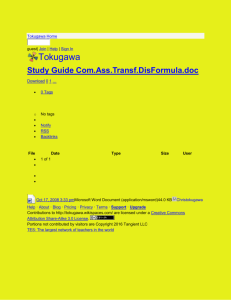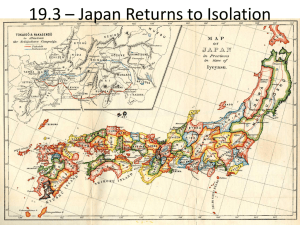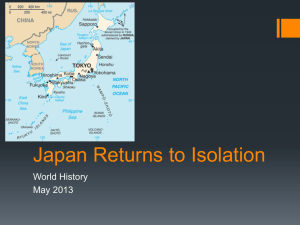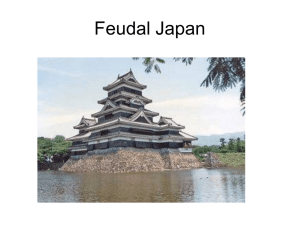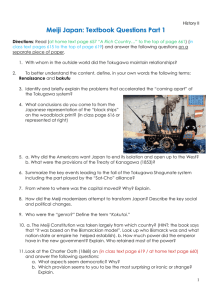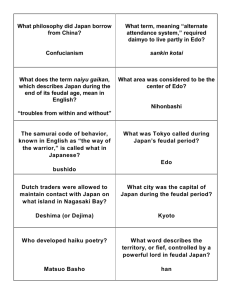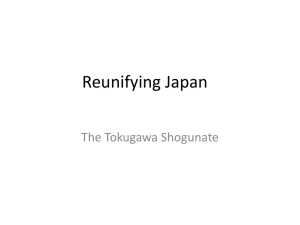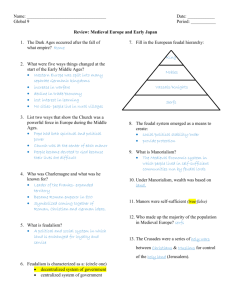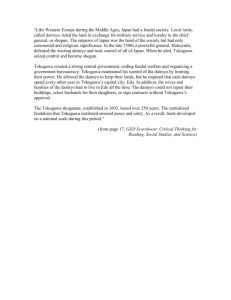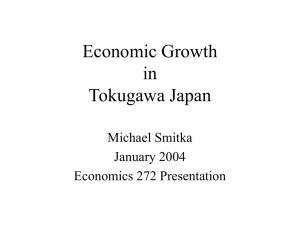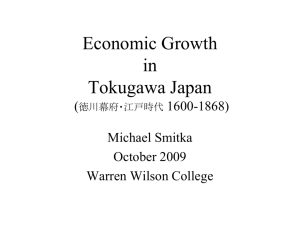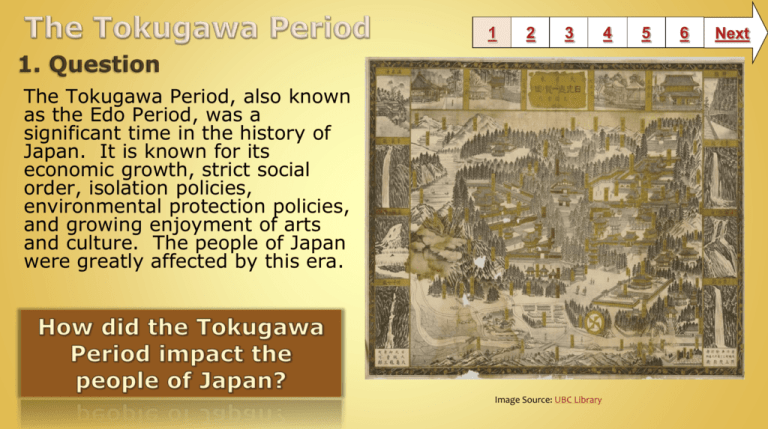
1
2
3
The Tokugawa Period, also known
as the Edo Period, was a
significant time in the history of
Japan. It is known for its
economic growth, strict social
order, isolation policies,
environmental protection policies,
and growing enjoyment of arts
and culture. The people of Japan
were greatly affected by this era.
Image Source: UBC Library
4
5
6
Next
1
2
As you use the information sources below,
organize your new knowledge of the people
of the Tokugawa Period in order to complete
the Student Activity on Slide 3.
Read more about the Tokugawa/Edo
Period.
Read about the caste system of Feudal
Japan.
Read about the Rules of the Edo Period.
Enter Edo and choose a character. Learn
more about the people of the Tokugawa
Period.
Read more about the work of artisans.
Read more about merchants.
Read more about samurai.
Read more about shoguns.
Image Source: pbs.org
3
4
5
6
Next
1
2
3
4
Using what you have learned
about the people of the Tokugawa
Period, rank each caste 1-5
according to who had the greatest
impact on Japanese society.
(1 having the greatest impact and 5 having the least)
Record your conclusions, being
sure to include:
What role each caste played in
society
How roles affected people in each
caste
Impact of this caste on Japanese
society
Learning Checkpoint: Before moving on, have your
teacher give you feedback on your work.
Image Source: Epic World History
5
6
Next
1
2
Now that you have a new understanding of
the caste system of the Tokugawa Period,
answer this question:
How did the Tokugawa Period influence
the people of Japan?
Support your response with details
from your research on the Tokugawa
Period, the caste system, and the rules
of that period.
Organize your thoughts for your response.
Present your response as directed by your
teacher. Your teacher may have you choose
a Web 2.0 tool like Voki, a Flip cam video,
or Voice Thread to present your response.
If you choose to handwrite your response,
create a Wordle or Tagxedo to go with it.
Image Source: Marky Star Japan This!
3
4
5
6
Next
1
Image Source: Costume Museum
Image Source: About Food in Japan
web blogs
Image Source: Encyclopaedia Britannica
Create
2
3
4
5
6
Next
a Fakebook page for a
person from one of the social
classes you researched.
Dress of the Tokugawa Period:
See how different people in the
Tokugawa Period dressed and
learn the names for each article
of clothing.
Food of the Edo Period: Learn
more about popular food during
the Edo Period.
Japanese Architecture: View
architecture in Japan.
1
BCPS Curriculum
O-15 Students will investigate political leadership in Japan during the Feudal and modernization
periods in order to assess its consequences for Japan and the world.
KSI-A Describe the importance of the samurai in Feudal Japan
KSI-B Determine how samurai prevented social and political change in Feudal Japan
KSI-C Describe how isolationism prevented modernization in Feudal Japan
Maryland State Curriculum
Standard 5.0 History
Students will examine significant ideas, beliefs, and themes; organize patterns and events; and
analyze how individuals and societies have changed over time in Maryland and the United
States.
Topic A. Individuals and Societies Change Over Time
Indicator 1. Analyze how the rise of the earliest communities led to the emergence of
agricultural societies
Objective b
Explain how and why towns and cities grew from early human settlements, including the need
for security and government
Topic B. Emergence, Expansion and Changes in Nations and Empires
Indicator 1. Analyze how civilizations emerged in the river valley areas
Objective a
Describe the characteristics of a civilization, such as social hierarchy, government, writing
system, specialization in an area of trade and the establishment of cities
Common Core State Standards
Reading: 1. Read closely to determine what the text says explicitly and to make logical
inferences from it; cite specific textual evidence when writing or speaking to support conclusions
drawn from the text.
Writing: 7. Conduct short as well as more sustained research projects based on focused
questions, demonstrating understanding of the subject under investigation.
2
3
4
5
6
Standards for the 21st Century Learner
1.1.6 Read, view, and listen for information presented in any
format (e.g. textual, visual, media, digital) in order to make
inferences and gather meaning.
2.1.3 Use strategies to draw conclusions from information and
apply knowledge to curricular areas, real-world situations, and
further investigations.
Maryland Technology Literacy Standards for Students
3.0: Use a variety of technologies for learning and collaboration.
Time Frame: Two fifty-minute class periods
Differentiation:
Direct students to use comprehension tools included in
databases, such as: audio read-aloud, labeled reading levels,
and embedded dictionaries.
Organizers may be modified to meet the needs of students.
Activity Assessment: Students may choose to hand write their
response to the question.
Learning Styles: Visual, Kinesthetic, Tactile, Active, Reflective,
Global Understanding, Analytical Understanding
Notes to the teacher: Look over the resources on Slide 2. You
may chose which sources you would like the students to use. Slide
4 provides some presentation options , but feel free to change them
to meet the needs of your class.
Last updated: July 2013
Created by Laura Herzog, Classroom Teacher/Library Media Intern
BCPS Slam Dunk Research Model, Copyright 2013, Baltimore County Public Schools, MD, all rights reserved. The models may be used for educational, non-profit school use only.
All other uses, transmissions, and duplications are prohibited unless permission is granted expressly. This lesson is based on Jamie McKenzie’s Slam Dunk Lesson module.

